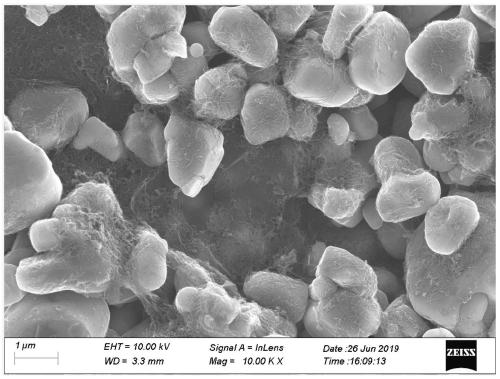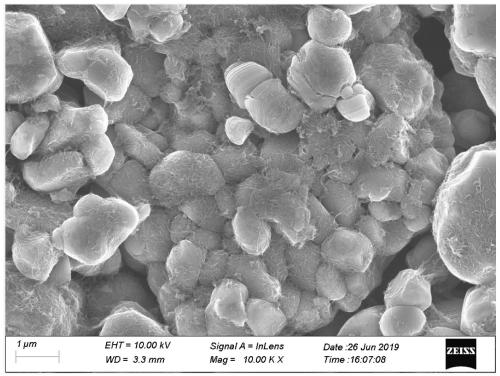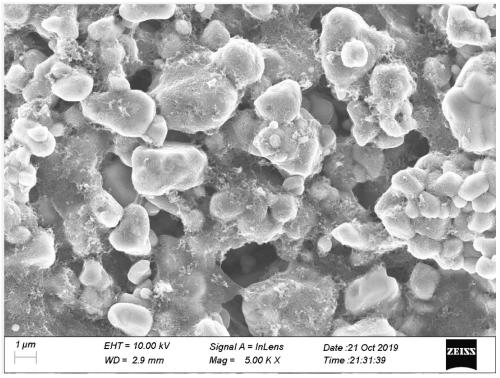Lithium ion battery positive electrode slurry as well as preparation method and application thereof
A lithium-ion battery, cathode slurry technology, applied in battery electrodes, positive electrodes, secondary batteries, etc., can solve the problems affecting the electrochemical performance of single-crystal ternary cathodes, poor electronic conductance and ion transport of cathode sheets, and electronic conductance. problems such as poor ion transmission and poor ion transmission, to achieve the effect of being conducive to liquid absorption, high gram capacity, and improved electronic conductance
- Summary
- Abstract
- Description
- Claims
- Application Information
AI Technical Summary
Problems solved by technology
Method used
Image
Examples
Embodiment 1
[0054] (1) Preparation of cathode slurry for lithium-ion batteries
[0055] The positive active material is a single crystal ternary material (LiNi 0.8 co 0.1 mn 0.1 o 2 ), the binder is polyvinylidene fluoride (PVDF), the solvent is N-methylpyrrolidone (NMP), and the conductive agent includes a first conductive agent and a second conductive agent. Preparation methods include:
[0056] 1) Add graphene, carbon nanotubes and conductive carbon black into a solvent containing a dispersant, mix uniformly and grind to a fineness of not more than 40 μm to obtain the first conductive agent, wherein carbon nanotubes, graphene, conductive carbon black, The mass ratio of dispersant and solvent is 1.5:0.5:2:1:95.
[0057] 2) mixing and stirring the positive electrode active material, PVDF, the first conductive agent and NMP to obtain a mixed slurry;
[0058] 3) adding a second conductive electrode to the mixed slurry for stirring to obtain a positive electrode slurry,
[0059] Wher...
Embodiment 2
[0065](1) Preparation of cathode slurry for lithium-ion batteries
[0066] The difference with embodiment 1 is:
[0067] In the first conductive agent, the mass ratio of carbon nanotubes, graphene, conductive carbon black, dispersant and solvent is 2:0.5:1.4:1.1:95;
[0068] The mass ratio of the total mass of carbon nanotubes, graphene and conductive carbon black in the first conductive agent to the second conductive agent is 2:0.5;
[0069] The mass ratio of the total mass of the positive electrode active material, the binder, the first conductive agent and the second conductive agent to the solvent is 60:1:21:18.
[0070] (2) Making lithium batteries by using the prepared lithium-ion battery cathode slurry
[0071] With embodiment 1.
Embodiment 3
[0073] (1) Preparation of cathode slurry for lithium-ion batteries
[0074] The difference with embodiment 1 is:
[0075] In the first conductive agent, the mass ratio of carbon nanotubes, graphene, conductive carbon black, dispersant and solvent is 2:0.8:3.2:1:94;
[0076] The mass ratio of the total mass of carbon nanotubes, graphene and conductive carbon black in the first conductive agent to the second conductive agent is 2:0.5;
[0077] The mass ratio of the total mass of the positive electrode active material, the binder, the first conductive agent and the second conductive agent to the solvent is 58:1:23:18.
[0078] (2) Making lithium batteries by using the prepared lithium-ion battery cathode slurry
[0079] With embodiment 1.
PUM
| Property | Measurement | Unit |
|---|---|---|
| Particle size | aaaaa | aaaaa |
| Diameter | aaaaa | aaaaa |
| Film diameter | aaaaa | aaaaa |
Abstract
Description
Claims
Application Information
 Login to View More
Login to View More - R&D
- Intellectual Property
- Life Sciences
- Materials
- Tech Scout
- Unparalleled Data Quality
- Higher Quality Content
- 60% Fewer Hallucinations
Browse by: Latest US Patents, China's latest patents, Technical Efficacy Thesaurus, Application Domain, Technology Topic, Popular Technical Reports.
© 2025 PatSnap. All rights reserved.Legal|Privacy policy|Modern Slavery Act Transparency Statement|Sitemap|About US| Contact US: help@patsnap.com



